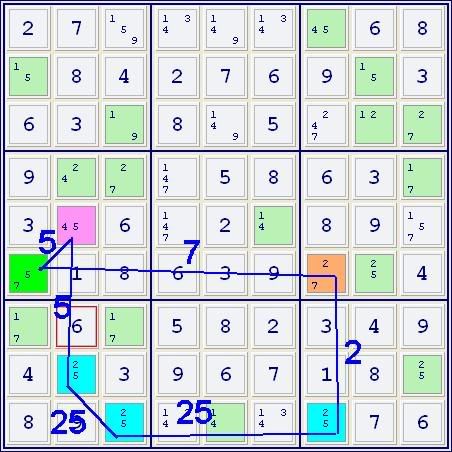Three people go into a hotel. The desk clerk says the rooms are $30, so each person pays $10 and goes to the room. Later, the clerk realizes that the room is only $25 and sends a bellhop to thre room with the $5 difference. The bellhop couldn’t figure out how to split the $5 three ways, so instead, gives each person a dollar and keeps $2 as a “tip”. Each person paid $9 for the room -- a total of $27 -- the bellhop kept $2 -- that makes $29. Where’s the extra dollar?
Of course, there is no extra dollar. They paid $27, two of which is in the bellhop's pocket. The other three are back in their wallets. The "extra dollar" is a phantom.
This is what you've done by including this other another chain. The point of forcing chains is this: If ALL candidates of a single cell lead can start an implication chain that lead to the same conclusion, since ONE of the candidates MUST be true, then the CONCLUSION must also be true. The fact that you can "assume r6c7 is 2" and find that it implies something different is the two dollars in the bellhop's pocket. In retrospect, the reason you can do this
is because your assumption was false! Forcing chains does NOT make any assumtions.
The chain could be thought of as a proof by contradiction, since if you assume there is a 5 in r5c2, the two sides of the chain lead to contradictory resultes in r6c7. This is valid, but some find this less satisfying since you are making an assumption -- a guess.
To be fair, the statement "Regardless of the candidate assigned in cell r6c7, the cell r5c2 must be 4." isn't quite accurate unless you restrict yourself to the highlighted cells. The point is that an implication chain can be made from each of the two candidates in r6c7 that lead to the same results in r5c2. The fact that other implication chains exist that don't agree does not matter. This will
often be the case.
Another way to look at the same situtation is to consider the forcing chain as a closed loop connected by labled edges:

This forms a loop with a single repetion:
[5]-[5]-[2(5)]-[(2)5]-[2]-[7]
The links in () are not used, leaving:
[5]-[5]-[2]-[5]-[2]-[7]
The 5s repeat -- eliminating the 5 in the cell they have in common.



